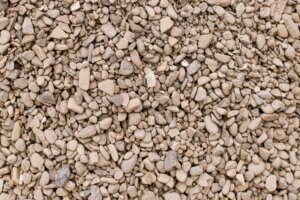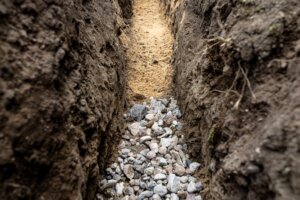The Ultimate Guide to Gravel: Pros, Cons, Types, and Uses
Gravel is one of the most versatile and widely used materials in construction, landscaping, and drainage solutions. It provides a natural, durable, and cost-effective option for a variety of applications, from roads and pathways to garden features and driveways.
At Armstrongs, we supply high-quality gravel sourced from our own quarries, ensuring reliability, consistency, and superior performance for all projects.
In this guide, we’ll explore the different types of gravel, their specific uses, and the key factors to consider when choosing the right gravel for your needs. We’ll also discuss the pros and cons of various gravel types to help you make informed decisions.
What is Gravel?
Gravel Definition and Composition
Gravel consists of small, loose fragments of rock that can either be naturally occurring or crushed from larger stones. Natural gravel forms over time through erosion and weathering, resulting in smooth, rounded stones.
Crushed gravel, on the other hand, is produced in quarries where larger rock is mechanically broken down to specific sizes.
Each type of gravel has unique properties that make it suitable for different applications. Natural gravel is often used for decorative landscaping and drainage, while crushed gravel is preferred for construction and road surfaces due to its angular shape, which provides better stability and compaction.
Common Gravel Sizes and Classifications
Gravel is classified based on particle size, ranging from fine aggregates to large stones. Choosing the right size is essential for ensuring proper performance in specific applications.
- Fine gravel (under 5mm): Ideal for pathways and decorative use, offering a compact, smooth finish.
- Medium gravel (5mm-20mm): Commonly used for driveways, drainage, and garden beds.
- Coarse gravel (20mm+): Best suited for road sub-bases, construction foundations, and heavy-duty drainage.
Selecting the correct gravel size impacts drainage, stability, and overall functionality in any project.
Types of Gravel and Their Uses
Types of Gravel for Driveways
Driveways require a durable and stable gravel type that can withstand vehicle traffic while maintaining a visually appealing surface. The most common options include:
- Crushed stone: A strong, angular gravel that compacts well, providing excellent stability for driveways.
- Self-binding gravel: A finer, compacting material that creates a smooth, uniform surface.
- Pea gravel: Rounded and aesthetically pleasing, but not ideal for high-traffic driveways as it tends to shift.
When choosing the best gravel for driveways in the UK, it’s important to consider factors such as drainage, maintenance, and durability.
Landscaping Gravel Types
Gravel is a popular choice for garden paths, decorative borders, and water features, offering both functionality and visual appeal. Some of the most common landscaping gravel types include:
- Pea gravel: Small, rounded stones that are ideal for walkways and flower beds.
- Crushed granite: A more durable option that provides excellent drainage.
- River rock: Smooth and aesthetically pleasing, often used for decorative water features.
Choosing the right landscaping gravel depends on the desired aesthetic, level of maintenance, and specific use.
Self-Binding Gravel: Pros and Cons
Self-binding gravel is a type of fine gravel that compacts tightly, creating a solid surface without the need for additional binding agents.
Pros:
- Requires minimal maintenance.
- Creates a smooth, firm surface ideal for walkways, cycle paths, and driveways.
- Reduces dust and loose movement compared to traditional gravel.
Cons:
- Can compact too tightly over time, affecting drainage.
- Requires careful installation to achieve a durable, long-lasting surface.
Coarse and Mixed Gravel Applications
Coarse gravel is essential for projects that require high durability, such as road foundations, drainage systems, and erosion control. Its angular edges provide excellent compaction and structural integrity.
Mixed gravel, which contains various particle sizes, is often used in road construction and utility projects where a well-graded blend enhances strength and stability.

Advantages of Gravel
Affordability
Gravel is one of the most cost-effective surfacing materials available, making it a budget-friendly alternative to concrete or paving.
It provides excellent coverage for large areas without requiring expensive installation methods. This makes it a popular choice for driveways, pathways, and landscaping projects.
Permeability
One of gravel’s biggest advantages is its natural drainage properties. Unlike solid surfaces such as concrete, gravel allows water to pass through, reducing the risk of surface water buildup, flooding, or erosion.
This makes it an ideal choice for driveways, pathways, and drainage solutions, particularly in the UK, where rainfall is frequent.
Aesthetic Appeal
Gravel offers a natural and versatile look, complementing various outdoor spaces, from rustic gardens to contemporary landscapes. With multiple colours, sizes, and textures available, it can be tailored to suit different project styles.
Popular choices like Cotswold chippings, crushed granite, and self-binding gravel provide a range of finishes for residential and commercial properties.
Easy Installation
Unlike concrete or tarmac, gravel requires minimal groundwork and preparation. It can be laid quickly and doesn’t require curing time, making it a fast and efficient surfacing solution.
This is particularly useful for projects with tight deadlines or those that require a low-maintenance surface.
Disadvantages of Gravel
Maintenance Needs
While gravel is durable, it can shift over time, particularly in high-traffic areas such as driveways and pathways.
Regular raking and occasional top-ups are needed to maintain an even surface. Additionally, harsh weather conditions, such as heavy rain or strong winds, may displace loose gravel.
Weed Growth
If gravel is not laid on a suitable weed barrier membrane, weeds can grow between the stones, leading to ongoing maintenance. Regular weed control or using self-binding gravel, which compacts more tightly, can help mitigate this issue.
Not Always Suitable for Heavy Loads
Certain types of gravel, such as pea gravel, may not support heavy traffic or vehicle loads without an adequate sub-base.
Choosing crushed stone or self-binding gravel ensures better compaction and stability for areas with frequent use.
Choosing the Right Gravel for Your Project
Best Gravel for Driveways in the UK
Selecting the right gravel for a driveway requires careful consideration of durability, drainage, and appearance. Some of the most recommended options include:
- Crushed Stone: Angular gravel that compacts well, offering excellent stability for driveways.
- Self-Binding Gravel: A fine, compacting gravel that forms a smooth, uniform surface with minimal movement.
- Cotswold Chippings: A decorative yet durable choice that blends well with traditional and modern properties.
For UK driveways, gravel that is well-graded, durable, and resistant to displacement will provide the best long-term performance.
Gravel for Walkways and Paths
Walkways require gravel that is comfortable underfoot while maintaining a stable, non-slip surface.
- Pea Gravel: Small, rounded stones that provide a softer, more natural look but may shift underfoot.
- Self-Binding Gravel: Compacts tightly, reducing movement and offering a firmer walking surface.
- Crushed Granite: A highly durable and visually appealing option that resists shifting.
Self-binding gravel is often the best option for footpaths, as it provides a solid, compact surface without the need for additional stabilisation.
Drainage and Utility Gravel
Proper drainage requires a well-graded, free-draining aggregate that allows water to flow effectively while preventing soil erosion.
- Coarse Gravel (10mm-40mm): Ideal for drainage trenches, soakaways, and French drains.
- Crushed Stone: Provides excellent stability and permeability in road foundations and construction projects.
- Granite Chippings: A hard-wearing option often used for pipe bedding and underground drainage.
Choosing the best gravel for drainage depends on the project requirements, but coarse, angular gravel is generally the most effective at preventing waterlogging and soil compaction.
Why Choose Armstrongs for Gravel Supply?
High-Quality Gravel from Trusted Quarries
At Armstrongs, we take pride in providing high-quality, locally sourced gravel that meets the highest industry standards. Our gravel is quarried, processed, and supplied directly from our own quarries, ensuring consistency, durability, and reliability for a variety of applications.
Whether you’re working on a construction project, a landscaping design, or a drainage system, our extensive selection of graded aggregates ensures that you get the right material for the job.
By sourcing locally, we also help reduce transportation costs and environmental impact, making our gravel a cost-effective and sustainable choice for both large-scale and domestic projects.
Sustainable and Cost-Effective Solutions
Sustainability is at the core of our operations. We are committed to responsible quarrying practices that minimise environmental impact while ensuring long-term availability of natural resources.
Our well-graded, free-draining aggregates help improve drainage efficiency, prevent erosion, and contribute to eco-friendly construction. By using recycled and locally sourced materials, we support sustainable construction and infrastructure development while keeping costs competitive.
Gravel FAQs
What is the best gravel size for driveways?
The ideal gravel size for driveways typically falls between 10mm and 20mm, as this provides a good balance of stability and drainage.
Smaller gravel (around 10mm) creates a smoother surface but may shift more easily, while larger gravel (20mm and above) offers greater durability but can be less comfortable to walk on.
Crushed stone is often preferred for its angular shape, which helps lock the gravel in place.
What type of gravel is best for walkways?
For walkways and footpaths, self-binding gravel and smaller aggregates (such as 6mm–10mm chippings) are excellent choices.
These materials provide a firm, compact surface that reduces movement underfoot while maintaining natural drainage. Crushed granite and pea gravel are also popular for their aesthetic appeal and durability.
Is self-binding gravel good for driveways?
Yes, self-binding gravel is a great option for low-maintenance driveways and pathways. It compacts over time to form a firm, stable surface that resists shifting, making it a durable alternative to loose gravel.
It also reduces dust and prevents weed growth, making it ideal for both residential and commercial applications. However, proper installation is key to ensuring long-term performance.
What is the best gravel for drainage?
For effective drainage, coarse, free-draining aggregates such as 20mm–40mm crushed stone or gravel are ideal. These materials allow water to pass through easily, preventing pooling and reducing surface water buildup.
Granite chippings, crushed limestone, and river rock are commonly used in soakaways, drainage trenches, and permeable surfaces. Choosing the right gravel for drainage ensures efficient water management and prevents soil erosion.
Read More
